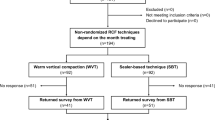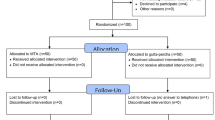Abstract
Objectives
The aim of this randomized clinical trial was to assess the effect of solvent use during the removal of root canal filling on postoperative pain after retreatment.
Materials and methods
Ninety patients scheduled for root canal retreatment were randomly assigned to one of the following two groups according to the root canal filling removal procedure used: ProTaper retreatment (Dentsply Maillefer, Ballaigues, Switzerland) instruments or ProTaper retreatment instruments in combination with gutta-percha solvent. A single operator performed the retreatments in a single visit. The incidence and intensity of the postoperative pain were rated on a numeric rating scale by patients at 24, 48, and 72 h after retreatment. The analgesic tablet intake number was also recorded. Data were analyzed using Mann‑Whitney U, Wilcoxon, and chi-square tests.
Results
For the intensity of postoperative pain, the difference between the two groups was not statistically significant. Moreover, no statistically significant difference was found between the two groups in terms of analgesic medication intake (P > 0.05).
Conclusions
The processes involving the use and non-use of a solvent in the removal of root canal fillings were found to be equivalent in terms of postoperative pain intensity and analgesic intake.
Clinical relevance
Some in vitro studies claimed that the use of a gutta-percha solvent in the removal of root canal fillings tends to reduce postoperative pain since extrusion of debris was significantly less. This randomized clinical trial indicates that the removal of root canal fillings with or without the use of a solvent was associated with equivalent postoperative pain intensity and analgesic intake.
This study is registered in the www.ClinicalTrials.gov database with the identifier number NCT03756363.

Similar content being viewed by others
References
Siqueira JF Jr (2003) Microbial causes of endodontic flare-ups. Int Endod J 36:453–463
Seltzer S, Naidorf IJ (2004) Flare-ups in endodontics: I. etiological factors. J Endod 30:476–481
Pirani C, Pelliccioni GA, Marchionni S, Montebugnoli L, Piana G, Prati C (2009) Effectiveness of three different retreatment techniques in canals filled with compacted gutta-percha or Thermafil: a scanning electron microscope study. J Endod 35:1433–1440
Betti L, Bramante CM (2001) Quantec SC rotary instruments versus hand files for gutta-percha removal in root canal retreatment. Int Endod J 34:514–519
Bürklein S, Schäfer E (2012) Apically extruded debris with reciprocating single-file and full-sequence rotary instrumentation systems. J Endod 38:850–852
Yılmaz K, Özyürek T (2017) Apically extruded debris after retreatment procedure with Reciproc, ProTaper next, and twisted file adaptive instruments. J Endod 43:648–651
Silva EJ, Sá L, Belladonna FG, Neves AA, Accorsi-Mendonça T, Vieira VT, Moreira EJ (2014) Reciprocating versus rotary systems for root filling removal: assessment of the apically extruded material. J Endod 40:2077–2080
Caviedes-Bucheli J, Castellanos F, Vasquez N, Ulate E, Munoz HR (2016) The influence of two reciprocating single-file and two rotary-file systems on the apical extrusion of debris and its biological relationship with symptomatic apical periodontitis a systematic review and meta-analysis. Int Endod J 49:255–270
Gordon MP (2005) The removal of gutta-percha and root canal sealers from root canals. N Z Dent J 101:44–52
Viducic D, Jukic S, Karlovic Z, Bozic Z, Miletic I, Anic I (2003) Removal of gutta-percha from root canals using an Nd:YAG laser. Int Endod J 36:670–673
Hülsmann M, Bluhm V (2004) Efficacy, cleaning ability and safety of different rotary NiTi instruments in root canal retreatment. Int Endod J 37:468–476
Kaplowitz GJ (1990) Evaluation of gutta-percha solvents. J Endod 16:539–540
Görduysus MO, Tasman E, Tuncer S, Etikan I (1997) Solubilizing efficiency of different gutta percha solvents: a comparative study. J Nihon Univ Sch Dent 39:133–135
Erdemir A, Eldeniz AU, Belli S (2004) Effect of the gutta-percha solvents on the microhardness and the roughness of human root dentine. J Oral Rehabil 31:1145–1148
Magalhães BS, Johann JE, Lund RG, Martos J, Del Pino FA (2007) Dissolving efficacy of some organic solvents on gutta-percha. Braz Oral Res 21:303–307
Pécora JD, Spanó JCE, Barbin EL (1993) In vitro study on the softening of gutta-percha cones in endodontic retreatment. Braz Dent J 4:43–47
Giuliani V, Cocchetti R, Pagavino G (2008) Efficacy of ProTaper universal retreatment files in removing filling materials during root canal retreatment. J Endod 34:1381–1384
Gu LS, Ling JQ, Wei X, Huang XY (2008) Efficacy of ProTaper universal rotary retreatment system for gutta-percha removal from root canals. Int Endod J 41:288–295
Takahashi CM, Cunha RS, Martin AS, Fontana CE, Silveria CF, da Silveira Bueno CE (2009) In vitro evaluation of the effectiveness of ProTaper universal rotary retreatment system for gutta-percha removal with or without solvent. J Endod 35:1580–1583
Ruddle C (2001) The ProTaper endodontic system: geometries, features and guidelines for use. Dent Today 20:60–67
Çanakçı BC, Er Ö, Dinçer A (2015) Do sealer solvents used effect apically extruded debris in retreatment. J Endod 41:1507–1509
Türker S, Uzunoğlu F, Sağlam BC (2015) Evaluation of the amount of extruded debris during retreatment of root canals filled by different obturation techniques. Niger J Clin Pract 18:802–806
Ørstavik D (1986) The periapical index: a scoring system for radiographic assessment of apical periodontitis. Endod Dent Traumatol 2:20–34
Ørstavik D (1996) Time-course and risk analyses of the development and healing of chronic apical periodontitis in man. Int Endod J 29:150–155
Rodriguez CS (2001) Pain measurement in the elderly: a review. Pain Manag Nurs 2:38–46
Johnson C (2005) Measuring pain. Visual analog scale versus numeric pain scale: what is the difference? J Chiropr Med 4:43–44
Siqueira JF Jr, Rôças IN, Favieri A, Machado AG, Gahyva SM, Oliviera JCM et al (2002) Incidence of postoperative pain after intracanal procedures based on an antimicrobial strategy. J Endod 28:457–460
Gama TGV, Machado de Oliviera JC, Abad EC, Rôças IN, Siqueira JF Jr (2008) Postoperative pain following the use of two different intracanal medications. Clin Oral Investig 12:325–330
Tsesis I, Faivishevsky V, Fuss Z, Zukerman O (2008) Flare-ups after endodontic treatment: a meta-analysis of literature. J Endod 34:1177–1181
Gehlot PM, Manjunath V, Manjunath MK (2016) An in vitro evaluation of four electronic apex locators using stainless steel and nickel titanium hand files. Rest Dent Endod 41:6–11
Al-Omari MA, Dummer PMH (1995) Canal blockage and debris extrusion with eight preparation techniques. J Endod 21:154–158
Haapasalo M, Udnæs T, Endal U (2003) Persistent,recurrent and acquired infection of the root canal system post-treatment. Endod Top 6:29–56
Chutich MJ, Kaminski EJ, Miller DA, Lautenschlager EP (1998) Risk assessment of the toxicity of solvents of gutta-percha used in endodontic retreatment. J Endod 24:213–216
Graunaite I, Skucaite N, Ladiene G, Agentiene I, Machiulskiene V (2018) Effect of resin based and bioceramic root canal sealers on postoperative pain: a split-mouth randomized clinical trial. J Endod 44:689–693
Arora M, Sangwan P, Tewari S, Duhan J (2016) Effect of maintaining apical patency on endodontic pain in posterior teeth with pulp necrosis and apical periodontitis: a randomized controlled trial. Int Endod J 49:317–324
Pak JG, White SN (2011) Pain prevalence and severity before, during, and after root canal treatment: a systematic review. J Endod 37:429–438
Hawker GA, Mian S, Kendzerska T, French M (2011) Measures of adult pain. Arthritis Care Res 63:240–252
Kusner G, Reader A, Beck FM, Weaver J, Meyers W (1984) A study comparing the effectiveness of ibuprofen (Motrin), Empirin with codeine #3, and Synalgos-DC for the relief of postendodontic pain. J Endod 10:210–214
Keiser K, Byrne BE (2011) Endodontic pharmacology. In: Hargreaves KM, Cohen S (eds) Pathways of the pulp, 10th edn. Mosby Elsevier, St Louis, pp 671–690
Walton R, Fouad A (1992) Endodontic interappointment flare-ups: a prospective study of incidence and related factors. J Endod 18:172–177
Mattscheck DJ, Law AS, Noblett WC (2001) Retreatment versus initial root canal treatment: factors affecting posttreatment pain. Oral Surg Oral Med Oral Pathol Oral Radiol Endod 92:321–324
Imura N, Zuolo ML (1995) Factors associated with endodontic flare- ups: a prospective study. Int Endod J 28:261–265
de Oliveira Alves V (2010) Endodontic flare-ups: a prospective study. Oral Surg Oral Med Oral Pathol Oral Radiol Endod 110:e68–e72
Comparin D, Moreira EJL, Souza EM, De-Deus G, Arias A, Silva EJNL (2017) Postoperative pain after endodontic retreatment using rotary or reciprocating instruments: a randomized clinical trial. J Endod 43:1084–1088
Wise EA, Price DD, Myers CD, Heft MW, Robinson ME (2002) Gender role expectations of pain: relationship to experimental pain perception. Pain 96:335–342
Ertan T, Şahinkesen G, Tunca YM (2010) Evaluation of postoperative pain in root canal treatment. Agri 22:159–164
Arias A, de la Macorra JC, Hidalgo JJ, Azabal M (2013) Predictive models of pain following root canal treatment: a prospective clinical study. Int Endod J 46:784–793
Watkins CA, Logan HL, Kirchner HL (2002) Anticipated and experienced pain associated with endodontic therapy. J Am Dent Assoc 133:45–54
Ng YL, Glennon JP, Setchell DJ, Gulabivala K (2004) Prevalence of and factors affecting post-obturation pain in patients undergoing root canal treatment. Int Endod J 37:381–391
Garcia-Font M, Durán-Sindreu F, Morelló S, Irazusta S, Abella F, Roig M, Olivieri JG (2018) Postoperative pain after removal of gutta-percha from root canals in endodontic retreatment using rotary or reciprocating instruments: a prospective clinical study. Clin Oral Investig 22:2623–2631
Moher D, Hopewell S, Schulz KF, Montori V, Gøtzsche PC, Devereaux PJ et al (2010) CONSORT 2010 explanation and elaboration: updated guidelines for reporting parallel group randomised trials. BMJ 340:c869
Acknowledgments
The authors gratefully acknowledge Prof. Dr. Sıddık Keskin for performing the statistical analysis.
Author information
Authors and Affiliations
Corresponding author
Ethics declarations
Conflict of interest
The authors declare that they have no conflict of interest.
Ethical approval
All procedures performed in this study were in accordance with the ethical standards of the institutional and/or national research committee and with the 1964 Helsinki declaration and its later amendments or comparable ethical standards.
Informed consent
Informed consent was obtained from each of the participants included in the study.
Additional information
Publisher’s note
Springer Nature remains neutral with regard to jurisdictional claims in published maps and institutional affiliations.
Rights and permissions
About this article
Cite this article
Genc Sen, O., Erdemir, A. & Canakci, B.C. Effect of solvent use on postoperative pain in root canal retreatment: a randomized, controlled clinical trial. Clin Oral Invest 24, 257–263 (2020). https://doi.org/10.1007/s00784-019-02948-3
Received:
Accepted:
Published:
Issue Date:
DOI: https://doi.org/10.1007/s00784-019-02948-3




